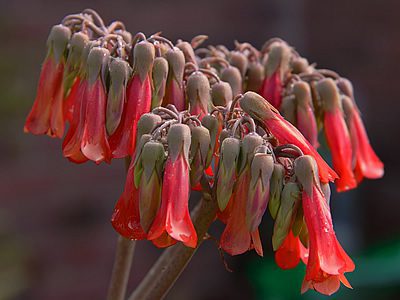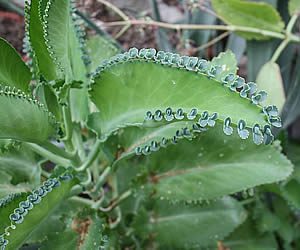The Devil’s Backbone (Kalanchoe daigremontiana), also known as Mother of Millions, is a herbaceous, succulent plant native to Madagascar in Africa. It is renowned for its ornamental appeal and medicinal value. At first glance, it may resemble an ordinary plant with different colors, but upon closer inspection, its popularity among collectors becomes evident. This plant produces hundreds of tiny buds along the edges of its leaves, which, when detached, easily develop into new plants. It has an upright stem that can grow up to 1 meter (about 3.3 feet) tall.
Its leaves are opposite, narrow, pointed, serrated, succulent, oblong to lanceolate in shape, and range from 15 to 20 centimeters (6 to 8 inches) in length. The color of the leaves can vary significantly, from green to cream and gray on the upper surface, with a varying amount of purple spots on the underside. Along the margins of the leaves, it produces an organized row of small buds that can root even before detaching from the plant. The heavy leaves at the top of the stem can cause the plant to bend over, and upon touching the ground, adventitious roots emerge, developing a new upright stem and thus growing a new independent plant.

Its flowering is not annual but sporadic. The main stem elongates well above the foliage, developing a terminal inflorescence of the cyme type, umbrella-shaped with small bell-shaped flowers in grayish-pink or orange. It is observed that in climates with distinct seasonal temperature differences, flowering is more frequent. Balcony or indoor plants that were moved inside because of the cold season started flowering at the beginning of winter.
The Devil’s Backbone is an unusual ornamental plant. It has an exotic appearance that is reminiscent of science fiction movies. Its size can be easily controlled by planting in pots and planters. Plants remain small in small pots and develop more in large pots or when planted directly in garden beds. In landscaping, its curious appearance can be further valued when planted in rock gardens with a desert inspiration, and in spacious contemporary beds covered with pebbles, enhancing its colors.

It should be grown in full sun or partial shade, in substrates suitable for cacti and succulents, light, sandy, perfectly drainable, and enriched with organic matter. Watering should be sparse, allowing the substrate to dry between waterings. Thus, watering should be more frequent in spring and summer and significantly reduced in autumn and winter.
Like many succulents, the Devil’s Backbone does not tolerate waterlogging, which leads to the rapid rotting of roots. Therefore, avoid using saucers under the pots or heavy substrates with poor drainage. It does not withstand intense cold, with snow or frost. It multiplies easily by leaf and stem cuttings and by seeds, and it is a viviparous plant that spontaneously generates new seedlings around it, through the separation of the small buds that grow along the leaves.


